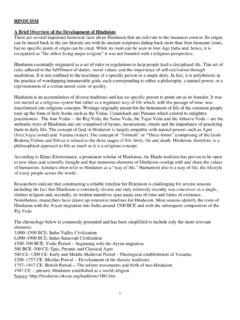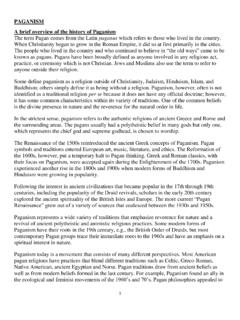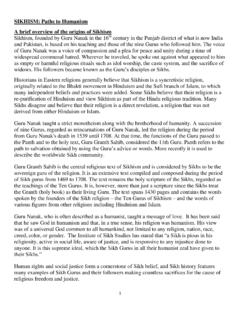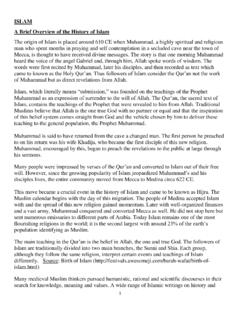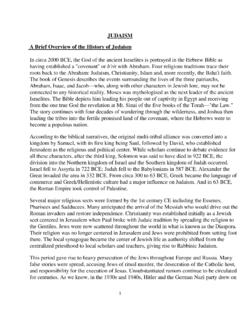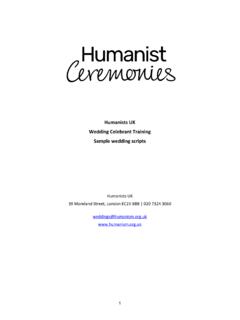Transcription of BUDDHISM A Brief Overview of the History of Buddhism
1 BUDDHISM A Brief Overview of the History of BUDDHISM BUDDHISM was believed to have started in India by Siddhartha Gautama. Siddhartha was born around the fifth century BCE to a tribal chief of a clan in southern Nepal. According to Buddhist literature, it was prophesied that he would become a king if he stayed at home or a great sage and the savior of humanity if he left. Siddhartha's father did not want his son to leave home because he wanted his son to be a king and follow in his footsteps. As the story goes, Siddhartha grew up surrounded by riches and luxury and knew only pleasures. He lived in palaces and was shielded from any pain or ugliness by his father so that he would not experience human suffering.
2 But Siddhartha became restless with his life of luxury. He wondered what else there was to life and demanded to see the outside world. His father gave in to his demand and allowed him to see the outside world, yet he tried to limit his experiences with others to young and healthy people. That is not what happened. According to the story, during his travels in the outside world, Siddhartha came across four sights that left a lasting impression on him. (1) Since he had never seen old and decrepit people before, he was shocked when he came across an old man. (2) When he was trying to find out more about old men he stumbled upon a very ill person.
3 This was even more shocking as he had never known or seen illness before. (3) Then he saw a funeral party by the side of a river. This too was new and most shocking of all for him. (4) Lastly, he encountered a traveling monk who had given up all the pleasures of the flesh. His face was so serene that the image stayed in Siddhartha s thoughts for a long time. Siddhartha is said to have learned some simple truths from which he had been shielded: we all get sick, grow old and die. He decided to abandon his previous life and devote himself to working out a way to end suffering. His initial method was to emulate the traveling monk, deny all pleasure, and follow a life of extreme asceticism.
4 But this state of being nearly killed him. What saved him was that one day he heard someone speak about the strings on a musical instrument: if a string is too tight it will break and be ruined; if it is too loose, you cannot make beautiful music. Siddhartha applied this to his own existence and formulated the idea of the Middle Way: do not deny the physical body totally and yet do not live life to indulge the body's every whim. Siddhartha meditated on this for some time and eventually came to an understanding of the concept of enlightenment. After this, he became known as Buddha or the enlightened one.
5 Eventually, he started teaching his philosophy and gained a large following. After going through a life of self-denial, discipline and meditation, he is said to have attained enlightenment which resulted in the alleviation of his pain and suffering. He then embarked on a journey of teaching others the path that would liberate them from the cycle of life and death. Gradually, BUDDHISM spread to numerous countries. The original Indian foundation was expanded by the inclusion of Central Asian, East Asian, and Southeast Asian cultures. Today BUDDHISM has spread to almost all the countries of the world with the population of Buddhists estimated to be around 500 million.
6 The largest population is in China, while Thailand, Cambodia and Myanmar have the highest proportion of Buddhists in their population. BUDDHISM also is becoming more widely practiced in America, Australia and the United Kingdom. Although there are many divisions or schools within BUDDHISM , there are two main branches which differ in some areas of focus. Theravada BUDDHISM focuses on individual enlightenment and experience as well as monastic life. Mahayana BUDDHISM focuses on collective freedom from suffering and teaching the ways to enlightenment. Zen and Tibetan BUDDHISM , both considered offshoots of the Mahayana tradition, are the two types of BUDDHISM most people in western countries practice.
7 THE KEY PRINCIPLES OF BUDDHISM BUDDHISM is different from many other faith traditions in that it is not centered on the relationship between humans and a high god. Buddhists do not believe in a personal creator God. In a sense then, BUDDHISM is more than a religion; it is a tradition that focuses on personal spiritual development. To many, it is more of a philosophy and a humanistic way of life which can be summed up as striving to lead a moral life; being aware of one s thoughts and actions; and developing wisdom, compassion and understanding. The key principles with which are briefly outlined below.
8 BUDDHISM s Four Noble Truths, the Eightfold Path and The Middle Way The Four Noble Truths are for those seeking enlightenment and refuge from suffering. In Brief , they are: (1) Suffering exists. (2) Suffering arises from attachment to desires. (3) Suffering ceases when attachment to desire ceases. (4) Freedom from suffering is possible by practicing the Eightfold Path. The Eightfold Path is expressed as the roads to the cessation of suffering and to enlightenment for the purpose of personal happiness and the happiness of all others. They are: (1) Right View/Right Understanding, (2) Right Thought/Right Intention, (3) Right Speech, (4) Right Action, (5) Right Livelihood, (6) Right Effort, (7) Right Mindfulness, and (8) Right Concentration.
9 The path is usually divided by Buddhist practitioners into three sections the wisdom section comprising of right understanding and right intention; the morality section comprising of right speech, right action and right livelihood; and the mental development section consisting of right effort, right mindfulness and right concentration. Volumes have been written about the principles of BUDDHISM by numerous scholars and spokespersons. The following three Brief illustrations reflect on the various components of the Buddhist perspective which relate to humanism. -- Paul Chiariello, assistant coordinator and webmaster at the humanist Chaplaincy at Rutgers University, has written that BUDDHISM and Humanism are two geographical sides of the same philosophical coin.
10 They re twins with the same DNA, separated at birth, and brought up by different BUDDHISM is Eastern Humanism and Humanism is Western BUDDHISM . He maintains that both have a common core in contrast to other worldviews concerning reason and compassion. For humanism, reason always has been the Summum Bonum (the highest good). With regard to compassion, he cites humanist Manifesto III: The lifestance of Humanism -- guided by reason, inspired by compassion, and informed by experience encourages us to live life well and fully. He also asserts that empathy is a central concept in both BUDDHISM and humanism and quotes what he termed a popular humanist notion: If you can t determine right from wrong, you lack empathy, not religion.
